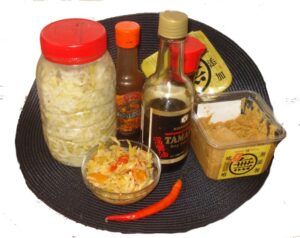Easy ways to add probiotic-rich food to your diet
Recipes for probiotic food : follow the link for a 14 page recipe guide.
Are you worried about pesticides?
“In a study about one of Korea’s infamous cultured foods, it was evidently observed that the probiotic strains found in Kimchi are able to completely degrade several kinds of organophosphorous pesticides within nine days of fermentation. In this study, they noted that various strains of lactic acid bacteria use these chemicals as one of their food sources.”
People who embrace old fashioned, slow farm-style cooking and eating uphold the art of pickling, brewing and culturing food. This enhances flavours, makes fibrous food more digestible and provides a steady stream of potent probiotics, especially lactobacillus. We can easily maintain these gut friendly bacteria without needing supplements by eating regular helpings of traditionally fermented foods every day.
Our gut health affects our immune system, digestion, our emotions, energy levels and our brain function. So a sound mind in a healthy body with a healthy gut really does depend on the consumption of bacteria, fungus, mould and slime! They come from delicious fermented foods we can easily make and take ourselves.
Examples of fermented food:

Sauerkraut, kimchi, yoghurt, amasi, kefir, cottage cheese, all popular cheeses, olives, pickles like gherkins, tobasco sauce, soy sauce, Worcester sauce, tamari, natto, miso, sour bread, kombucha, beer, wine and pickled lemons. Learn how to make a few of them with my basic guidelines. Making your own kimchi is a good way to begin as it introduces lactic acid – a by product of anaerobic fermentation, giving it a sour taste, without adding vinegar.
Recipes for probiotic food follow the link for a 14 page recipe guide